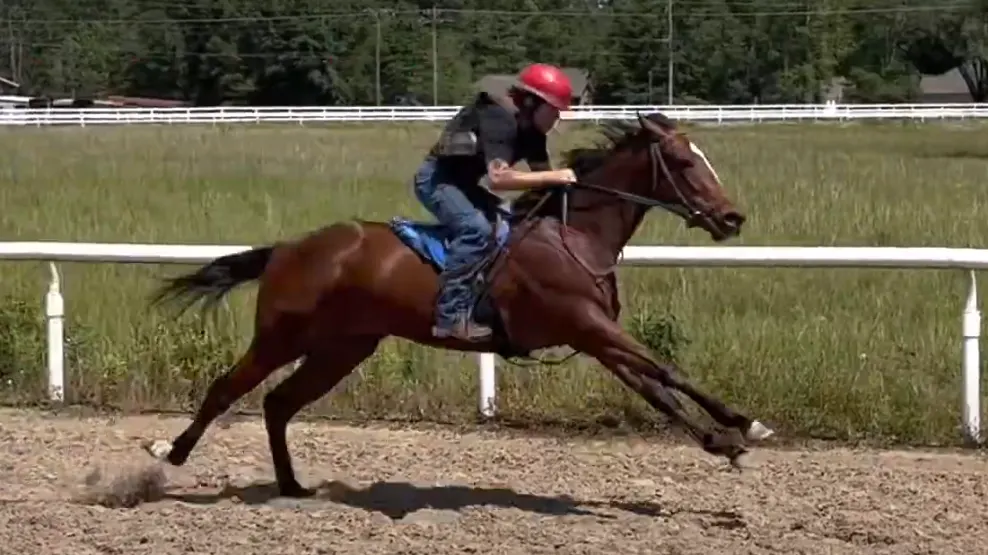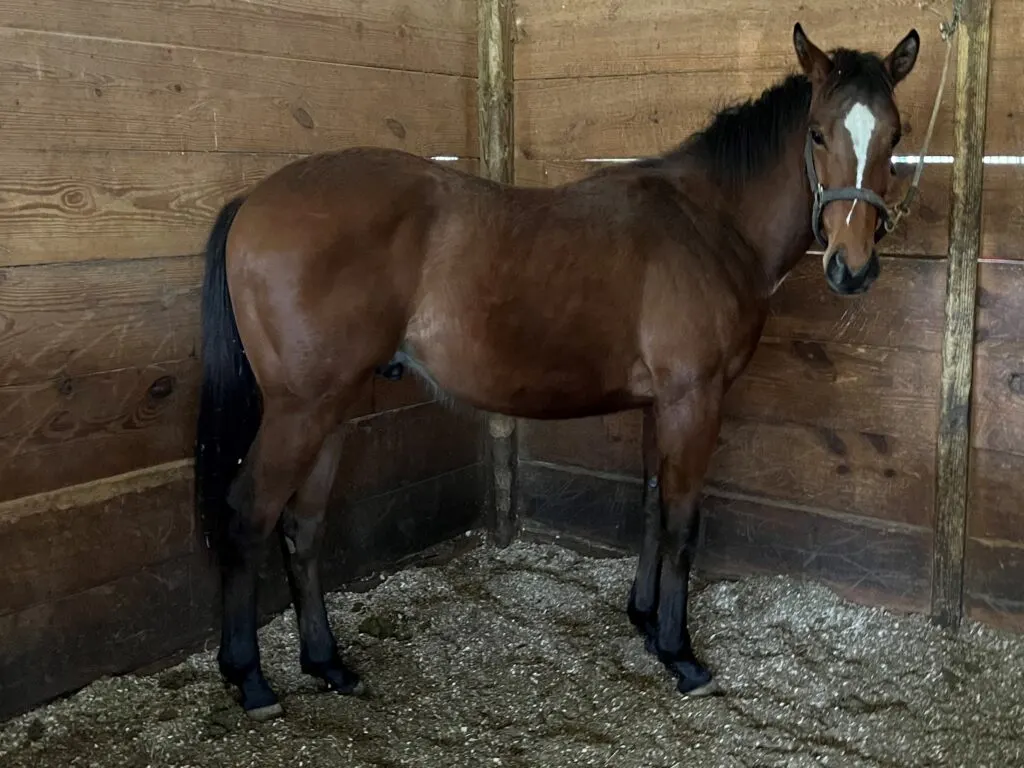Last updated: December 6, 2022
Any links on this page that lead to products on Amazon are affiliate links and I earn a commission if you make a purchase. Thanks in advance – I really appreciate it!
Before running trails or jumping hurdles on your horse, think about warming them up first. A warm-up reduces stress, lowers the chances of injuries, and loosens muscles. But what is the best way to warm-up your horse?
Warming up a horse in three easy steps: 1) start with a slow walk, 2) gradually increase the intensity, and 3) introduce flexibility exercises, such as figure-eight maneuvers.
Everyone wants to warm-up their horse as quickly as possible, but to warm up correctly involves doing activities at a slow and less intense pace. There are important reasons, slow and steady is recommended.

Warming up your horse.
Sometimes your horse needs to get its feet under itself before you start working it. I suggest lunging your horses or putting it on a walker if you have one.
Slow and steady activities warm-up your horse and prepare its body for higher energy activities. These measures help to reduce muscle soreness and lessen the risk of injury.
Lunge your horse
Some people lunge horses to work on behavior problems, but it is an excellent way to warm up a stiff horse or cool down an excited young horse before tacking up.
Lunging is the act of driving your horse around you in a circle while it’s attached to a rope. You use your body language and voice to get the horse to respond.
I suggest you work the horse in both directions and keep him moving for a few minutes to warm up his body and get his mind focused on working with you.
Plus, a tempered warm-up gives a horse’s heart, blood vessels and breathing, a chance to ease into an exercise session.
Warm-up right before you intend to ride. In other words, don’t warm up your horse, then put it back in the stall to ride later.
Walk
Take it easy and walk your horse slowly for a good 5-10 minutes. Walking engages large muscle groups that are mostly slow-twitch fibers. The capillaries of these fibers dilate during activity and warm the muscles.
During your walk, stop and reverse directions. Ideally, mimic some of the movements of your chosen activity to loosen your horse’s muscles and tendons. If your horse is older, it may require more walking time.
Walking not only helps warm your horse, but it also gives him time to focus mentally.
Move to a slow gallop during the second step of warmups.
Once you’ve completed five or so minutes of walking at a low, slow pace, gradually increase to a brisk walk, trot, and finally advance to a slow gallop. Keep the same patterns used during your walk.
Ride in different directions, and perform some of the equine exercises you intend to focus on during your training. This activity doesn’t need to be extensive 5-10 minutes typically suffices.
Increase your horse’s flexibility during warmup.
Increase flexibility with figure eights
Incorporate figure eights during your ride. Once you completed step 2, drop back down to a walk and ride a figure eight. You want to loosen your horse further and increase its flexibility.
It would be best if you rode in both directions for the optimal results. After walking the pattern, pick up the pace and continue to flex your animal riding figure eights or similar ways.
After warm-up allow your horse time to recover.
Our recommended warm-up should produce mild sweating and increased heart rate but generally won’t fatigue your animal. After you finish your flexibility exercises let your cool down with five minutes of relaxed walking.
Your horse should recover to its normal resting heart rate and breathing pattern relatively quickly. If your animal’s heart stays elevated or it continues to breathe hard after 10 minutes, it’s either out of shape or has a medical condition.
Be flexible with your warmup routine.
Horses are individuals, and no plan is designed for each horse. It would be best if you considered the weather, age, and breed of your horse, and its fitness level. The steps provided are a useful guide but adjust it for your horse’s needs.

Warming up your horse is critical.
Warming up your horse loosens muscles, prevents injury, and prepares the animal mentally and physically to perform its best. For horses exercised at high-intensity, a warm‐up increases their energy supply.
Exercise increases the temperature of muscles. Warm muscles improve its elasticity and contracts and relax quicker than cold muscles, which reduces better performance and less risk of injury.
The temperature of the blood increases, which allows better circulation and makes oxygen more available to working muscles. More oxygen to muscles should improve endurance.
Exercise increases the temperature of muscles. Warm muscles improve its elasticity and contracts and relaxes quicker than cold muscles, which reduces better performance and less risk of injury.
During warm-up, a horse’s capillaries and blood vessels dilate, which increases blood flow and reduces stress on its heart. Large muscles and joints loosen, and their range of motion increases.
Warming up your horse can prevent overheating by activating its body’s cooling mechanism, which is especially critical for high-intensity activities, such as racing.
During a slow, measured warm-up, both you and your horse can mentally prepare for the task ahead. This mental preparation is more effective if warm-ups are part of your regular routine.

Warming up a horse in cold temperatures.
Don’t put your horse in a stall and quit riding because of the cold weather. Horses need exercise all year long if you can’t ride, turnout your horse, or work him on the ground.
Horses with clipped coats or thin coats should be blanketed in extreme temperatures. Even when riding, it’s best to use a quarter sheet to provide extra protection.
Warming up your horse is essential, but in winter, it may even be more so. In cold weather horses, muscle fatigue sooner and also are likely to develop soreness.
Walk your animal first, either by riding at a slow pace, or working with a longe line or use a walker. Walking stress-free is critical because you want to engage the large muscle groups and increase blood flow.
Once you’ve walked your horse sufficiently, start slowly increasing intensity. Trot and gallop, and follow the three steps above. Remember to pay close attention to your animal’s heart rate and breathing.
Modify your horse’s diet in the winter.
I’ve always heard that horses tolerate cold climates better than warm weather. They grow thick coats that provide insulation to keep them warm when temperatures drop.
Horses need to eat more in winter.
Start with the basics and provide a healthy winter diet. Horses burn energy to keep warm, so you need to increase its feed in the winter. Ask a feed specialist or veterinarian how many extra calories your horse requires.
Horses need more water in winter.
Horses need water to stay hydrated and for their organs to function correctly. A typical horse drinks 10-12 gallons a day. During the spring and summer months, pasture horses get water when they eat grass.
But, in winter, they don’t have grass to supplement their drinking water. They are likely to eat dry hay or feed with very little moisture content. Provide access to water at temperatures between 45 and 65 degrees Fahrenheit in the winter.
A horse that doesn’t drink enough water can dehydrate, which leads to a myriad of health complications, including colic.

Provide shelter so your horse can escape the elements.
Your pasture should have a place for horses to escape wind chill, sleet, and snow. It could be a simple open front shed or a run-in attached to the side of a barn. The shelter pictured above is simple yet effective in protecting animals from the elements.
In our area, the temperatures don’t drop extremely low, but we still provide shelters to protect our horses from rain and wind. They also like to step in the cover to escape the sun on hot summer days.
A blanket may be needed in winter.
Blankets can be useful to help keep your horse warm in the winter. They are most effective for pasture horses without available shelter, but the blankets could become wet, which leads to problems.
Blankets are also useful for horses that have been clipped, are old, young, or not acclimated to the cold weather. If you decide to blanket your horse, make sure it fits correctly. If the blanket doesn’t fit your horse, it can cause sores.
Also, each day you need to remove the blanket and inspect it for damage and make sure it is secured correctly. Remove a wet blanket and allow it to dry before putting it back on your horse, and never cover a wet horse with a blanket.
Below is an interesting YouTube video about how to warm up a horse’s topline before riding.
Related articles:
- What is Colic in a Horse? Causes and Symptoms
- Is My Horse Overweight? A Plan to Reduce Weight Safely
- Is Your Horse Too Skinny to Ride? Let’s Find Out!
- What does a Horse Eat? An Essential Guide
- Cleaning Hoofs, Leads to a Healthier Horse
- 12 Horse Coat Colors: Patterns, Genetics, and Pictures
Meet Miles Henry
An avid equestrian and seasoned racehorse owner, Miles Henry brings his extensive experience to the equine world, proudly associating with the AQHA, The Jockey Club, and various other equine organizations. Beyond the racetrack, Miles is an accomplished author, having published various books about horses, and is a recognized authority in the field, with his work cited in multiple publications.
🔗 Connect with Miles:
Twitter
Facebook
YouTube: Check out race highlights, horse care tips, and more!

